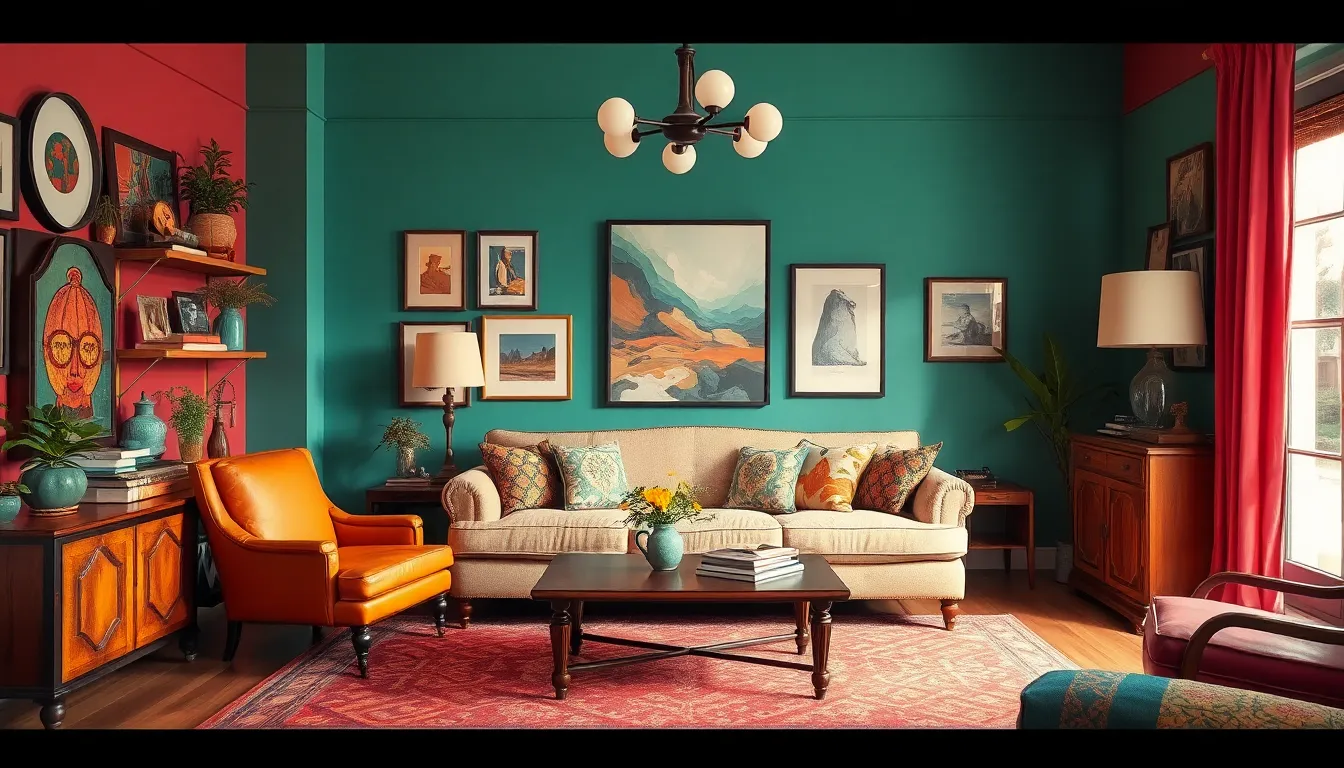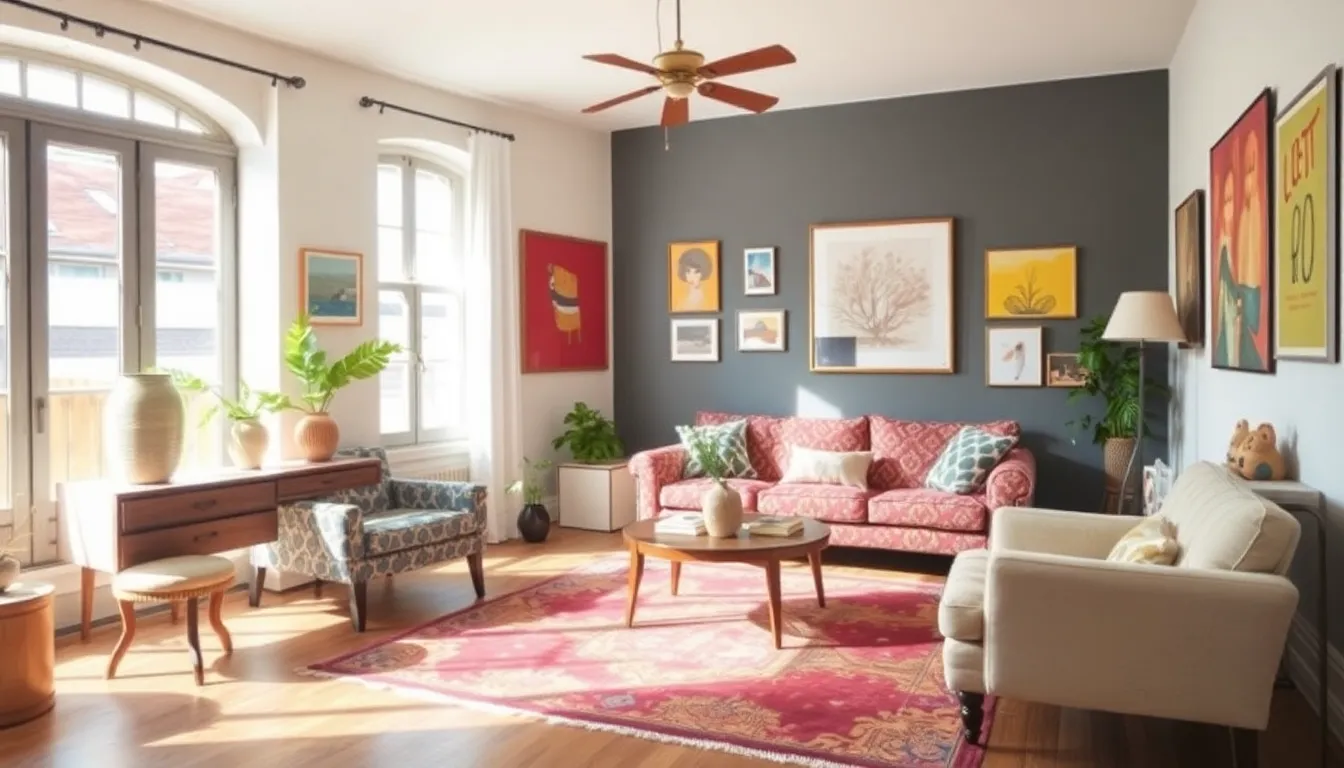Eclectic design is like a thrilling rollercoaster ride for the senses, blending styles and eras in a way that makes every room feel like a fabulous treasure hunt. Imagine walking into a space where vintage charm dances with modern minimalism, and bold colors play hide-and-seek with subtle textures. It’s a delightful chaos that not only breaks the rules but also rewrites them with flair.
Table of Contents
ToggleUnderstanding Eclectic Design
Eclectic design captures a unique blend of styles and influences, creating personalized and stimulating interiors. This approach invites creativity while disregarding strict design rules.
Definition of Eclectic Design
Eclectic design refers to an interior decorating style that merges diverse influences. It combines elements from different eras, cultures, and design philosophies, emphasizing individuality. Through blending contrasting materials and aesthetics, eclectic design offers a fresh perspective on space. Each room reflects the homeowner’s personality, showcasing their journey through unique pieces and styles. The resulting atmosphere feels cohesive despite its inherent diversity.
Key Characteristics of Eclectic Design
Eclectic design features several distinct characteristics. Bold colors often dominate spaces, with vibrant hues juxtaposed against muted tones. Varied textures play a crucial role; rough surfaces may contrast with smooth finishes. Mixing patterns adds visual interest, encouraging a playful approach to decor. Vintage items frequently coexist with contemporary pieces, creating a multidimensional experience. Layering furniture styles enhances warmth and depth, drawing the eye across the room. Overall, eclectic design invites exploration, encouraging individuals to appreciate the beauty of contrast.
Elements of Eclectic Design

Eclectic design incorporates a rich variety of elements that foster uniqueness and charm. Each aspect contributes to an inviting space filled with character and individuality.
Color Palette
Bold colors dominate the eclectic design palette, creating an energetic atmosphere. Bright hues often coexist with more subdued tones, balancing vibrancy and calmness. Layers of different shades invite visual interest, forming a cohesive yet dynamic look. Colors can reflect personal tastes, pulling inspiration from various cultures and time periods. Mixing and matching unexpected combinations, like jewel tones with pastels or earth tones, fuels creativity and expression.
Textures and Materials
Textures add depth and warmth to eclectic interiors. Mixing smooth surfaces, like glass and metal, with rough ones promotes contrast and visual intrigue. Natural materials such as wood and stone often blend seamlessly with synthetic finishes. Soft textiles, like velvet or woven fabric, enhance comfort and create inviting seating arrangements. Combining elements like reclaimed wood and shiny metal can create a striking focal point.
Furniture and Décor
Furniture selection showcases a mix of styles and eras in eclectic design. Vintage pieces, such as antique sofas or classic chairs, complement modern designs like sleek tables or contemporary lighting. Unique décor items, including art pieces and collectibles from travel, add personal stories and memories. Statement furniture draws the eye and serves as conversation starters. Combining unusual shapes, colors, and functions enriches the décor and reflects diverse influences.
Popular Styles Within Eclectic Design
Eclectic design features several popular styles, each contributing unique characteristics that enhance its diverse nature.
Bohemian Style
Bohemian style embraces a carefree and artistic spirit. Rich colors, intricate patterns, and an array of textures define it. Ornate textiles, layered rugs, and the use of macramé often feature prominently. Furniture usually includes vintage finds, like mid-century chairs mixed with ethnic artifacts. Plants, such as succulents and large leafy varieties, add a natural touch and vitality. Artwork varies from bold paintings to eclectic wall hangings, creating a vibrant atmosphere that invites self-expression.
Vintage Style
Vintage style draws inspiration from past eras, often incorporating elements from the 1920s to the 1980s. Key characteristics include antique furniture, retro accessories, and classic color palettes. Iconic pieces, such as a 1950s diner table or an Art Deco vase, can stand out. Mixing elements from different decades adds depth and visual interest. Patterns like paisley and floral can be highlighted in upholstery or wallpaper, enhancing nostalgia. This style transforms spaces by marrying the charm of yesteryear with contemporary elements.
Modern Mix
Modern mix style balances sleek lines with warmth and character. Clean, minimalist furniture paired with bold accent pieces creates a striking juxtaposition. Sleek metal or glass surfaces often complement plush, textured fabrics. Color schemes can range from neutral bases to vibrant pops that energize the room. Architectural elements may include exposed beams or open spaces that enhance flow. Accessories, such as geometric sculptures or oversized artwork, serve as focal points that reflect personal taste and creativity.
Tips for Achieving an Eclectic Look
Creating an eclectic look involves a thoughtful combination of various elements. Achieving this unique style requires attention to detail and personal expression.
Choosing a Focal Point
Select a standout piece to anchor the room. A large artwork or an impressive piece of furniture can serve as this focal point. This strategic choice draws the eye and provides a cohesive element that balances the rest of the decor. When furniture or art pieces stand out, they establish a narrative that sets the tone for the entire space. Position other items around this focal point to enhance visual interest and create harmony throughout the room.
Balancing Elements
Mix contrasting elements to forge a balanced aesthetic. Combining different textures, colors, and styles achieves a mesmerizing dynamism. For instance, pairing a sleek modern sofa with a vintage rug introduces depth. Scale and proportion remain vital; ensure larger items don’t overshadow smaller pieces. Creating contrast through differing designs while maintaining a harmonious palette engenders a cohesive atmosphere. Utilizing a limited color scheme can unify the diverse elements, ensuring they complement rather than conflict.
Incorporating Personal Style
Infuse personal touches to make the space uniquely yours. Displaying travel souvenirs, family heirlooms, or handmade items adds meaningful context. Authenticity shines through when reflecting one’s personality and experiences. Mixing sentimental pieces with contemporary designs enhances eclectic charm. When curated with intention, these items create opportunities for storytelling within the decor. Engage with the space by continuously evolving its design as new inspirations emerge, keeping the aesthetic fresh and lively.
Embracing eclectic design opens the door to a world of creativity and personal expression. It allows individuals to curate spaces that reflect their unique journeys and tastes. By blending various styles and influences, eclectic design transforms interiors into vibrant tapestries of color and texture.
This approach encourages experimentation with bold hues and diverse materials, fostering an inviting atmosphere that captivates the senses. The beauty of eclectic design lies in its ability to tell a story through carefully chosen elements that resonate with the homeowner’s personality.
Ultimately, eclectic design is not just a style; it’s a celebration of individuality that brings warmth and charm to any space.






